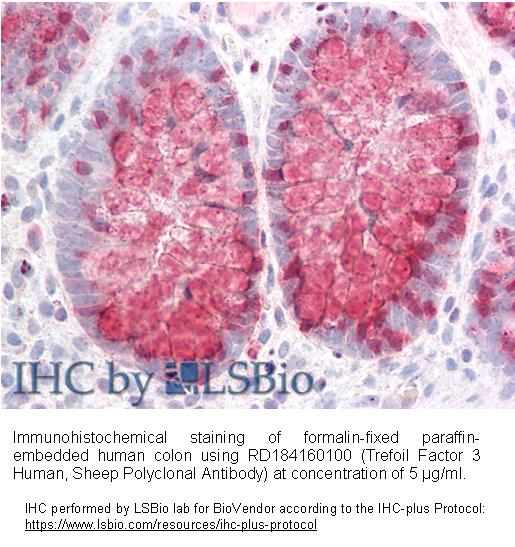Type
Polyclonal Antibody
Applications
Western blotting, ELISA, Immunohistochemistry
Antibodies Applications
Source of Antigen
E. coli
Hosts
Sheep
Preparation
The antibody was raised in sheep by immunization with the recombinant Human Trefoil Factor 3.
Amino Acid Sequence
The immunization antigen (7.82 kDa – calculated) is a protein containing 69 AA of recombinant Human Trefoil Factor 3. N-terminal His-tag, 10 extra AA.
MKHHHHHHASEEYVGLSANQCAVPAKDRVDCGYPHVTPKECNNRGCCFDSRIPGVPWCFKPLQEAECTF
Species Reactivity
Human. Not yet tested in other species.
Purification Method
Immunoaffinity chromatography on a column with immobilized recombinant Human Trefoil Factor 3.
Antibody Content
0.1 mg (determined by BCA method, BSA was used as a standard)
Formulation
The antibody is lyophilized in 0.05 M phosphate buffer, 0.1 M NaCl, pH 7.2.
Reconstitution
Add 0.2 ml of deionized water and let the lyophilized pellet dissolve completely. Slight turbidity may occur after reconstitution, which does not affect activity of the antibody. In this case clarify the solution by centrifugation.
Shipping
At ambient temperature. Upon receipt, store the product at the temperature recommended below.
Storage/Expiration
The lyophilized antibody remains stable and fully active until the expiry date when stored at -20°C.Aliquot the product after reconstitution to avoid repeated freezing/thawing cycles and store frozen at -80°C. Reconstituted antibody can be stored at 4°C for a limited period of time; it does not show decline in activity after one week at 4°C.
Quality Control Test
Indirect ELISA – to determine titer of the antibody
SDS PAGE – to determine purity of the antibody
BCA - to determine quantity of the antibody
Note
This product is for research use only.
Research topic
Energy metabolism and body weight regulation, Oncology, Renal disease, Sepsis
Summary
Trefoil factor 3 (TFF3, also known as intestinal trefoil factor) belongs together with TFF1 and TFF2 to a small group of mucin-associated peptides. TFF3 contains seven cysteine residues, six of which form disulfide bonds to create a characteristic three-leafed structure. Due to its compact structure, TFF3 is extremely resistant toward acids, proteolytical cleavage or heat degradation. Monomeric form of TFF3 consists of 60 amino acids and has 6.7 kDa, while the dimer (13.1 kDa) consists of 118 amino acids. TFF3 is expressed mainly in gastrointestinal tract, in the mucous cells of the small and large intestine, where it maintains the integrity of mucous layer and in cooperation with mucins protects the gastrointestinal epithelial cells against various injurious agents. However, TFF3 was also detected in salivary glands, posterior pituitary gland and in the inner ear. Secretion of TFF3 is triggered by the presence of certain inflammation mediators and neurotransmitters. Studies showed that oral administration of TFF3 in rats protects gastric mucosa from damage. Over-expression of TFF3 occurs at the sites of damage of the gastrointestinal tract, e.g. peptic ulcer or inflammatory bowel disease. Patients suffering from these diseases have increased levels of TFF3 in serum. TFF3 was reported to be over-expressed also in patients with various neoplasms including intestinal, pancreatic and prostate carcinomas. On the contrary, its expression decreases in thyroid follicular carcinomas. In vitro studies showed that in breast cancer cells, expression of TFF3 is regulated by the level of estrogen. Recent study with human and rodent pancreatic islet β-cells has demonstrated that TFF3 overexpression increases their proliferation. Both major forms of diabetes involve a decline in islet β-cells mass and their controlled expansion would have great potential utility for treatment of this diseases. Another study with rats has shown that urinary TFF3 protein levels were markedly reduced in response to renal tubular injury, while his levels did not respond to nonrenal toxicants.

